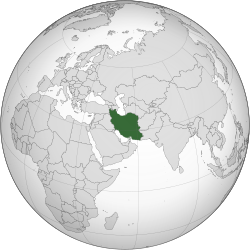
Back Persiese Ryk Afrikaans Persien ALS الإمبراطورية الفارسية Arabic Persia AST Персідская імперыя Byelorussian Персийска империя Bulgarian ফার্সি সাম্রাজ্য Bengali/Bangla Perzija BS Imperi Persa Catalan Perská říše Czech
Persian Empire كُشُورْ شَاهِنْشَاهَى اىْرَانْ (Persian) Kešvar-è Šâhanšâhi-ye Irân[a] | |
|---|---|
| 727 BC–1979 AD | |
| Anthem: (1925–1933) سلامتی دولت علیّه ایران Salâmati-ye Dowlat-è Âlliye-ye Irân ("Salute of the Sublime State of Iran") (1933–1979) سرود شاهنشاهی ایران Sorud-è Šâhanšâhi-ye Irân ("Imperial Anthem of Iran") | |
 Persian Empire in Achaemenid period (widest borders) | |
 Map of the Pahlavi Iran period | |
| Status | Empire |
| Capital | Tehran (1925–1979) |
| Common languages |
|
| Government | Monarchy |
| History | |
• Established | 727 BC |
• Disestablished | 1979 AD |
| Area | |
| 500 BC[16][17] | 5,500,000 km2 (2,100,000 sq mi) |
| 1 AD[16][17] | 2,800,000 km2 (1,100,000 sq mi) |
| 550 AD[16][17] | 3,500,000 km2 (1,400,000 sq mi) |
| 1925 AD | 1,648,195 km2 (636,372 sq mi) |
| Population | |
• 500 BC[18] | 17–35 million |
The Persian Empire, or Iranian Empire (Persian: شَاهِنْشَاهَى اىرَانْ, romanized: Šâhanšâhi-ye Irân), refers to the dynastic-states of Persian origin that ruled Iran from the Medes to the Pahlavi period. "Persia" was the term used by outsiders; its people called the country "Iran".
Cite error: There are <ref group=lower-alpha> tags or {{efn}} templates on this page, but the references will not show without a {{reflist|group=lower-alpha}} template or {{notelist}} template (see the help page).
- ↑ Roemer 1986, p. 331.
- ↑ 2.0 2.1 2.2 Matthee 2008b.
- ↑ Ferrier 1989, p. 9.
- ↑ 4.0 4.1 Perry 2006.
- ↑ Cyril 2003, p. 392.
- ↑ Arnold 1939, pp. 514–515.
- ↑ Ruda 2006, p. 76.
- ↑ Davaran 2010, p. 156.
- ↑ Daryaee 2008, pp. 99–100.
- ↑ Green 1992, p. 45.
- ↑ Skjærvø 2006, pp. 348–366.
- ↑ Canepa 2018, p. 6.
- ↑ Wiesehöfer 2001, p. 119.
- ↑ Kittel et al. 2007, p. 1194–1195.
- ↑ Windfuhr 2006, p. 386–390.
- ↑ 16.0 16.1 16.2 Turchin, Adams & Hall 2006.
- ↑ 17.0 17.1 17.2 Taagepera 1979.
- ↑ Morris & Scheidel 2009, p. 77.

